LAIH 2020-2021 Virtual Luncheons Via Zoom
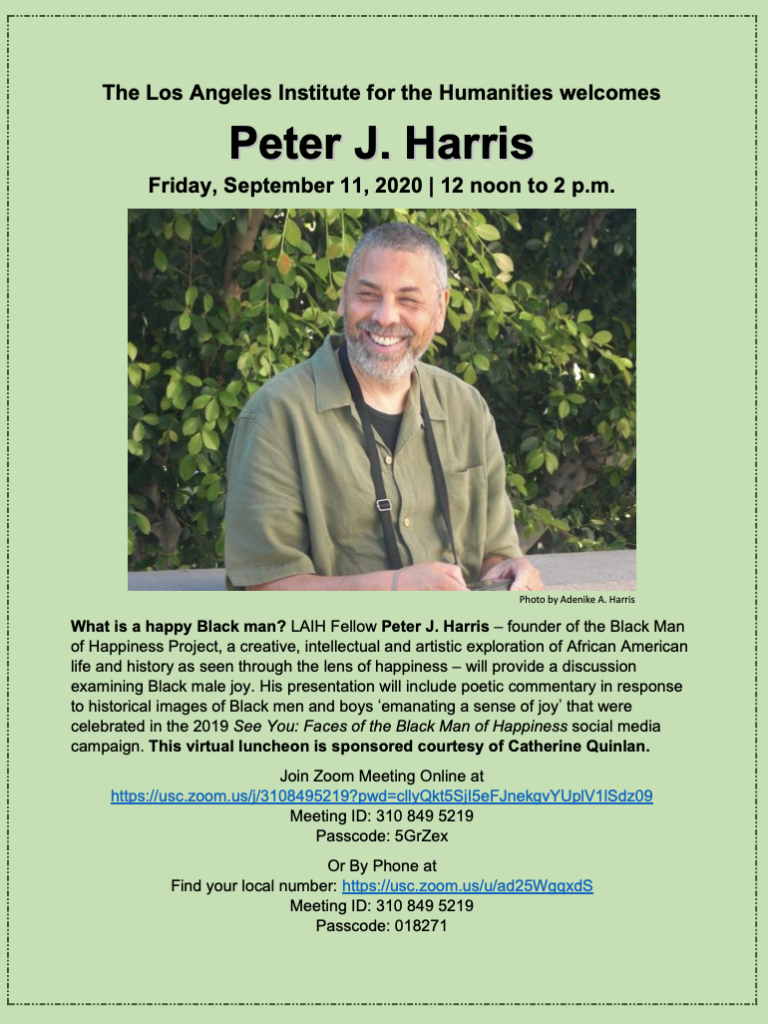
September 11: (rescheduled from Spring 2020) A discussion of black male joy by LAIH Fellow Peter J. Harris and founder of the Black Man of Happiness Project, a creative, intellectual and artistic exploration of African American life and history as seen through the lens of happiness. His presentation will include poetic commentary in response to historical images of Black men and boys ‘emanating a sense of joy’ that were celebrated in the 2019 See You: Faces of the Black Man of Happiness social media campaign. THIS LUNCHEON IS SPONSORED COURTESY OF CATHERINE QUINLAN

September 24: (rescheduled from Spring 2020) LAIH Fellow Tom Zoellner, author of Island on Fire: The Revolt That Ended Slavery in the British Empire. This discussion of Island on Fire, published in May 2020, provides an account of the 1831-32 slave revolt that unexpectedly made the final case for abolition throughout the British Empire.
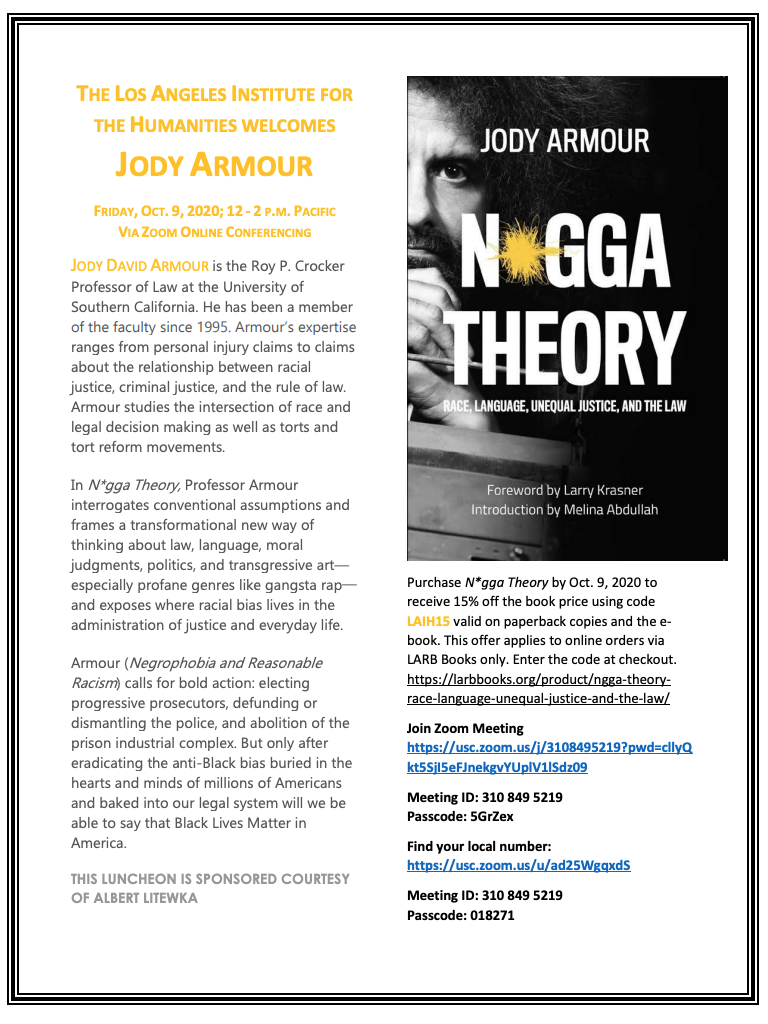
October 9: USC Law Professor Jody Armour to discuss his new book, N*GGA THEORY: Race, Language, Unequal Justice, and the Law, published in August 2020. “N*gga Theory interrogates conventional assumptions and frames a transformational new way of thinking about law, language, moral judgments, politics, and transgressive art—especially profane genres like gangsta rap—and exposes where racial bias lives in the administration of justice and everyday life.” THIS LUNCHEON IS SPONSORED COURTESY OF ALBERT LITEWKA
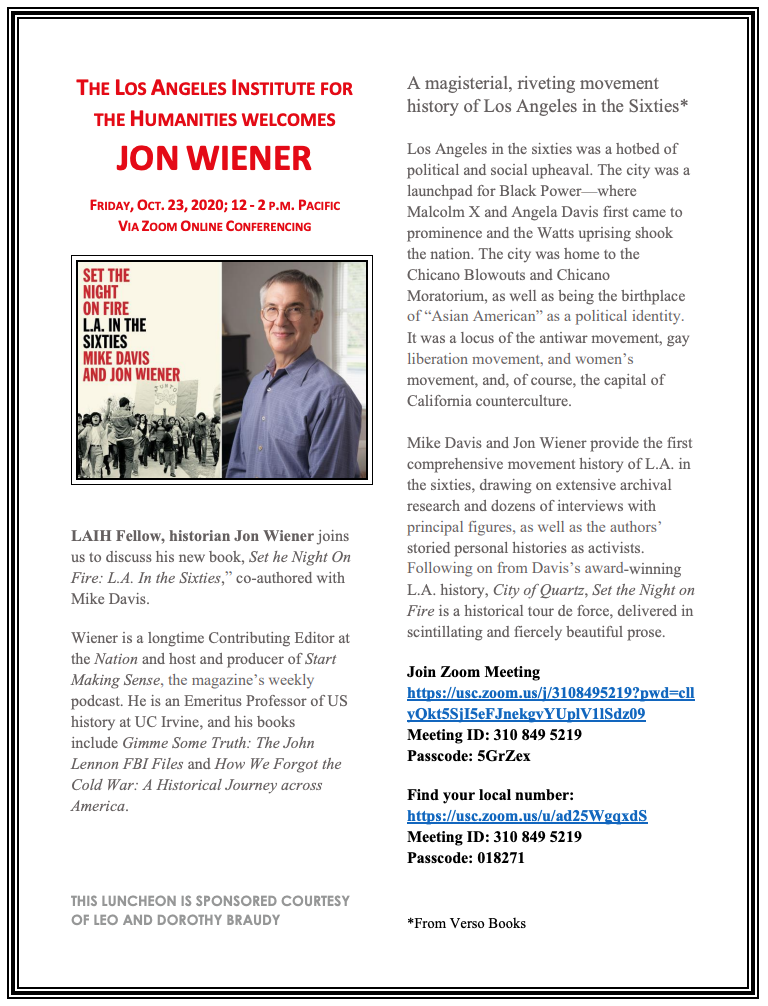
October 23: LAIH Fellow Jon Wiener presents Set the Night on Fire: L.A. In the Sixties. Co-authored with Mike Davis, Set the Night on Fire (published in April 2020) is the first comprehensive movement history of L.A. in the sixties, drawing on extensive archival research and dozens of interviews with principal figures, as well as the authors’ storied personal histories as activists. THIS LUNCHEON IS SPONSORED COURTESY OF LEO AND DOROTHY BRAUDY November 13: A Post-Election LAIH Virtual Town Hall with LAIH Fellow Marty Kaplan. THIS TOWN HALL LUNCHEON IS SPONSORED COURTESY OF THE NORMAN LEAR CENTER
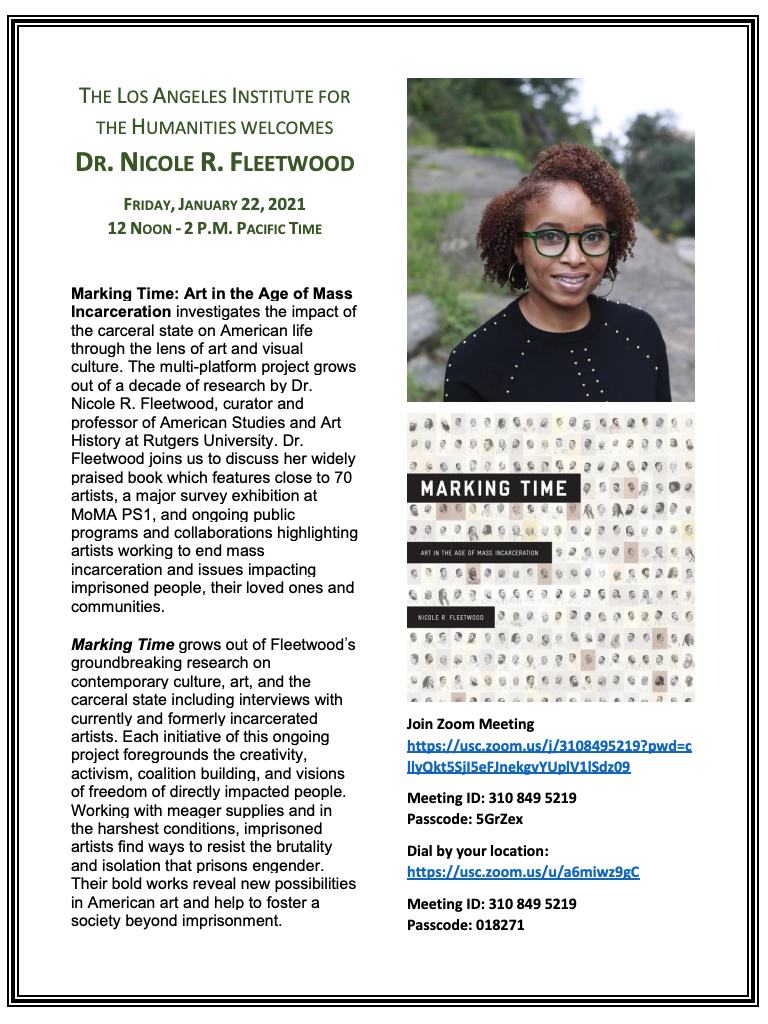
January 22: Dr. Nicole R. Fleetwood discusses Marking Time: Art in the Age of Mass Incarceration in which she investigates the impact of the carceral state on American life through the lens of art and visual culture.
The multi-platform project grows out of a decade of research by Dr. Fleetwood, curator and professor of American Studies and Art History at Rutgers University. Marking Time encompasses a highly praised book featuring close to 70 artists, a major survey exhibition at MoMA PS1, and ongoing public programs and collaborations highlighting artists working to end mass incarceration and issues impacting imprisoned people, their loved ones, and their communities. Dr. Fleetwood is a writer, curator, and professor of American Studies and Art History at Rutgers
University. She is the author of Marking Time: Art in the Age of Mass Incarceration (Harvard, 2020) and the curator of the exhibition of the same name, currently on view at MoMA PS1 through April 4, 2021.
-Introduction by Louise Steinman
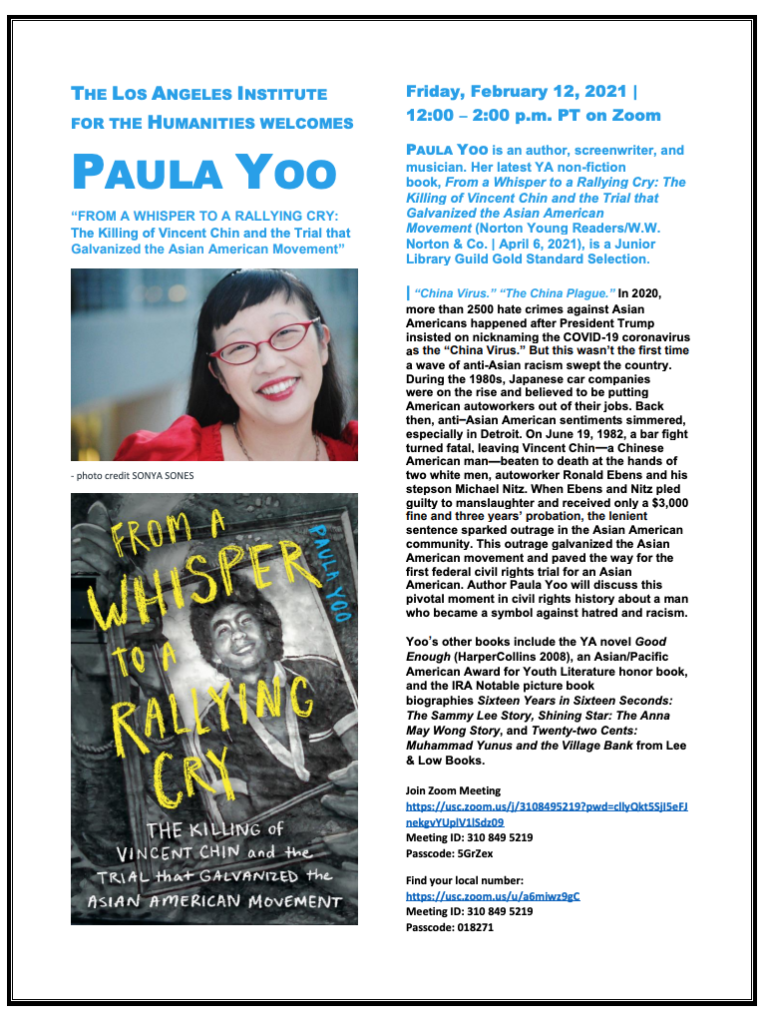
February 12: Paula Yoo’s debut YA nonfiction book, From a Whisper to a Rallying Cry: The Killing of Vincent Chin and the Trial that Galvanized the Asian American Movement (Norton, 2021), is a searing examination of the killing of Vincent Chin, and the trial and verdicts that followed. Chin was a Chinese-American whose beating death at the hands of two white autoworkers in Detroit in 1982 galvanized the Asian-American civil rights movement and led to stronger federal hate crime legislation.
Extensively researched from court transcripts and interviews with key case witnesses—many speaking for the first time—Yoo has crafted a suspenseful, nuanced, and authoritative portrait of a pivotal moment in civil rights history. Paula Yoo is an award-winning book author, TV writer/producer and feature screenwriter.
-Introduction by Janice Rhoshalle Littlejohn
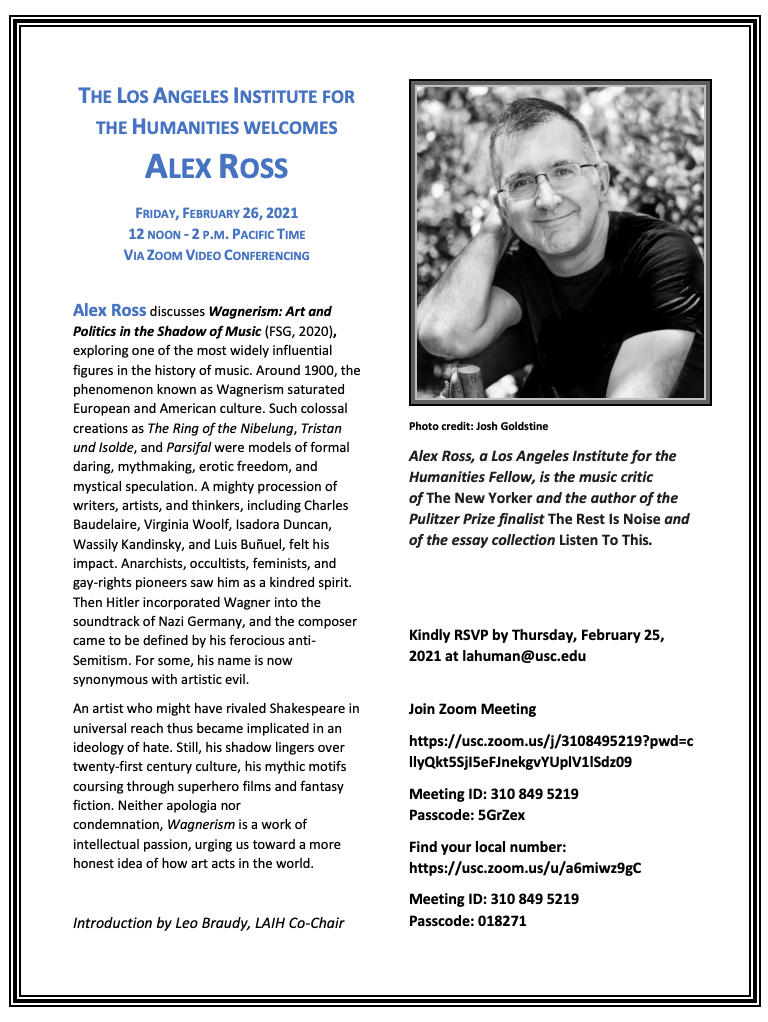
February 26: Fellow Alex Ross discusses Wagnerism: Art and Politics in the Shadow of Music (FSG, 2020), exploring one of the most widely influential figures in the history of music. Around 1900, the phenomenon known as Wagnerism saturated European and American culture. Such colossal creations as The Ring of the Nibelung, Tristan und Isolde, and Parsifal were models of formal daring, mythmaking, erotic freedom, and mystical speculation. A mighty procession of writers, artists, and thinkers, including Charles Baudelaire, Virginia Woolf, Isadora Duncan, Wassily Kandinsky, and Luis Buñuel, felt his impact. Anarchists, occultists, feminists, and gay-rights pioneers saw him as a kindred spirit. Then Hitler incorporated Wagner into the soundtrack of Nazi Germany, and the composer came to be defined by his ferocious anti-Semitism. For some, his name is now synonymous with artistic evil.
An artist who might have rivaled Shakespeare in universal reach thus became implicated in an ideology of hate. Still, his shadow lingers over twenty-first century culture, his mythic motifs coursing through superhero films and fantasy fiction. Neither apologia nor condemnation, Wagnerism is a work of intellectual passion, urging us toward a more honest idea of how art acts in the world.
Ross is the renowned New Yorker music critic and author of the international bestseller and Pulitzer Prize finalist The Rest Is Noise.
-Introduction by Leo Braudy
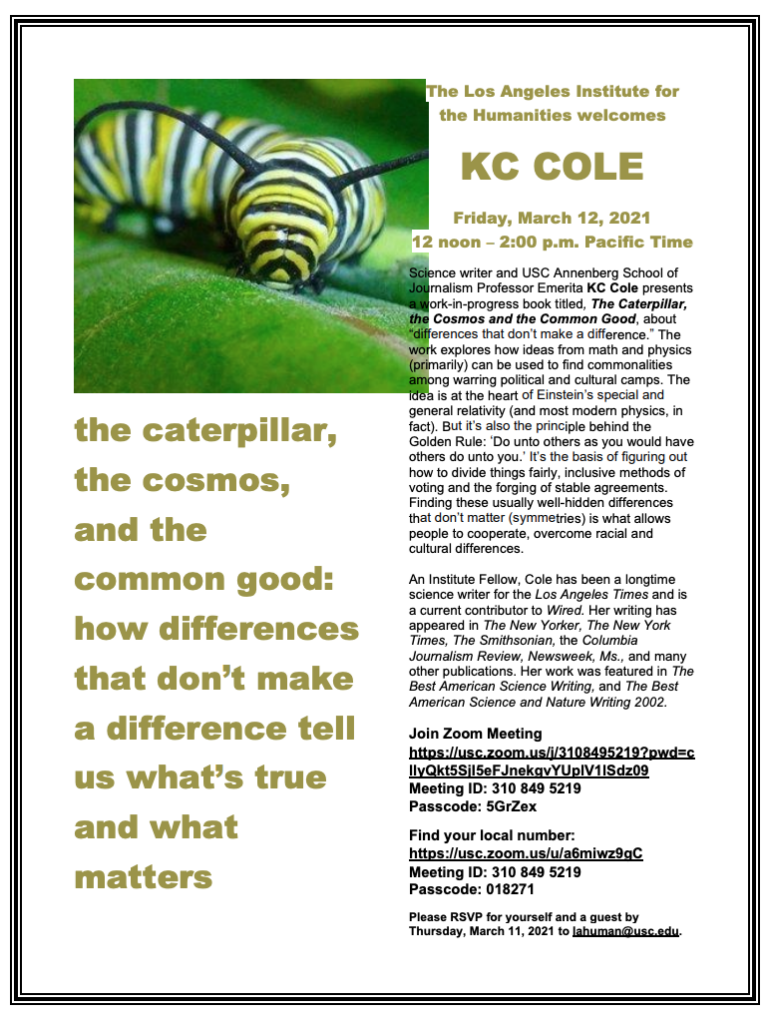
March 12: Fellow and USC Journalism Professor Emeritus KC Cole presents a work-in-progress book titled, The Caterpillar, the Cosmos and the Common Good, about “differences that don’t make a difference.” The work explores how ideas from math and physics (primarily) can be used to find commonalities among warring political and cultural camps. This idea, she argues, is at the heart of Einstein’s special and general relativity (and most modern physics, in fact). But it’s also the principle behind the Golden Rule: ‘Do unto others as you would have others do unto you.’ It’s the basis of such seemingly different processes as figuring out how to divide things fairly, inclusive methods of voting, and the forging of stable agreements. Finding these usually well-hidden differences that don’t matter (symmetries) is what allows people to cooperate, overcome racial and cultural differences.
-Introduction by Dr. Amy Parish
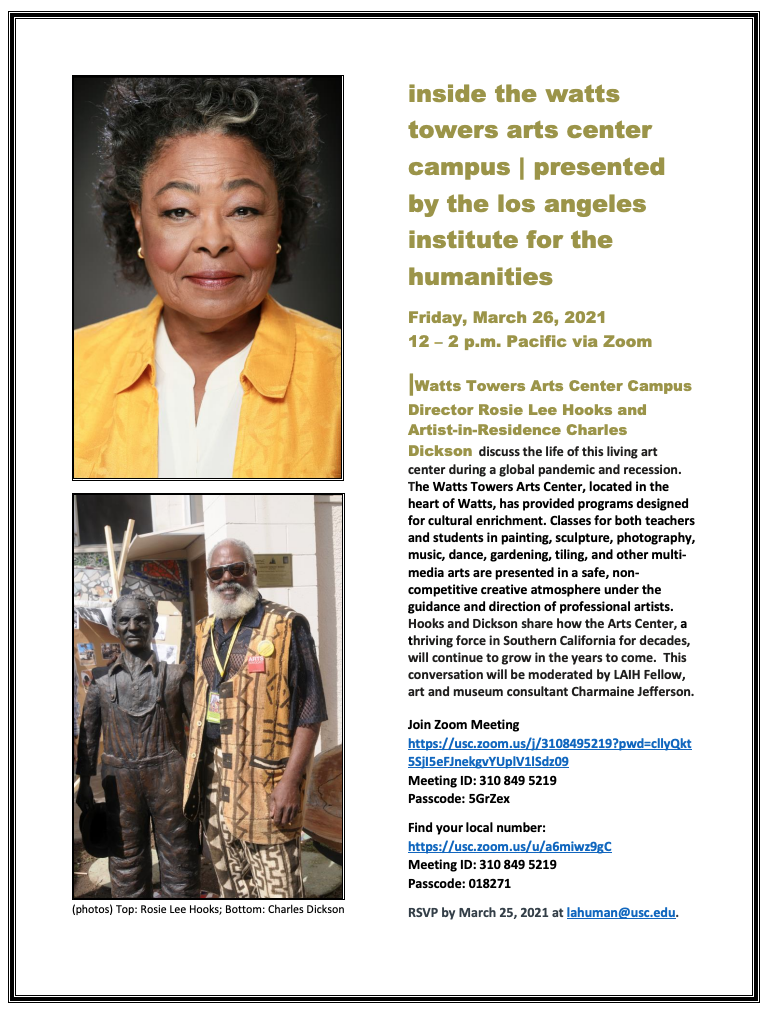
March 26: Watts Towers Arts Center Director Rosie Lee Hooks and Artist-in-Residence Charles Dickson discuss the life of this living art center during a global pandemic and recession. The Watts Towers Arts Center, located in the heart of Watts has provided programs designed for cultural enrichment. Classes for both teachers and students in painting, sculpture, photography, music, dance, gardening, tiling, and other multi-media arts are presented in a safe, non-competitive creative atmosphere under the guidance and direction of professional artists. Hooks and Dickson share how the Center, a thriving force in Southern California for decades, will continue to grow in the years to come.
-Introduction by Charmaine Jefferson
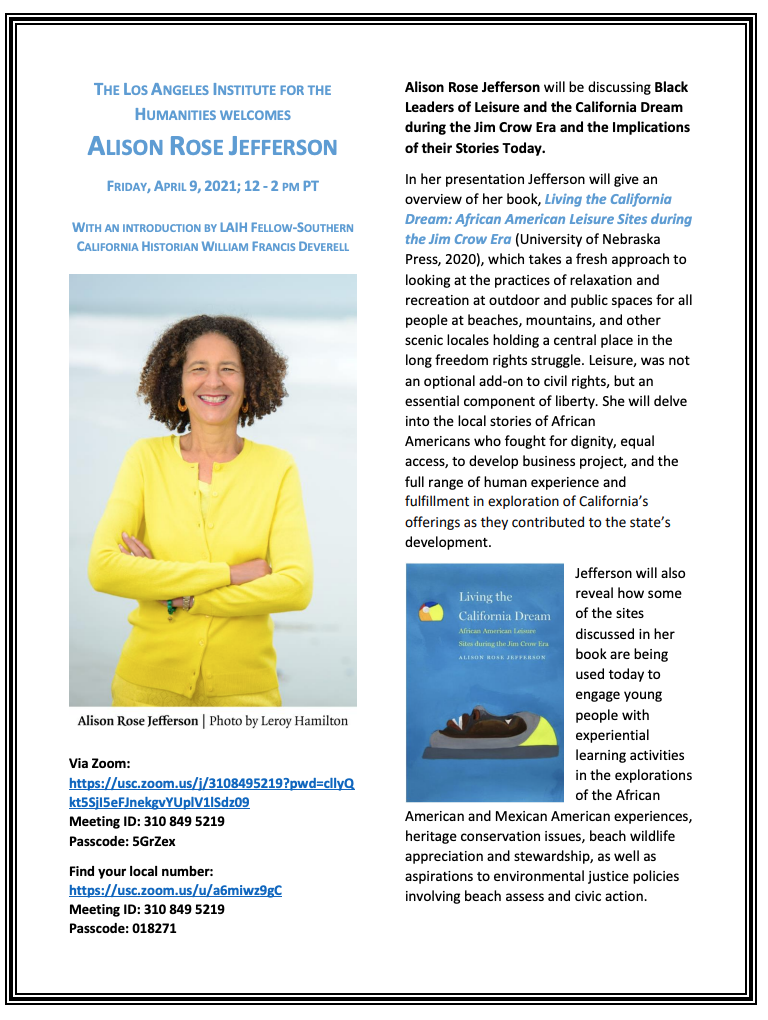
April 9: Historian and heritage conservation consultant Alison Jefferson discusses her book, Living the California Dream: African American Leisure Sites During the Jim Crow Era (Nebraska, 2020) which received the Miriam Matthews Ethnic History Award from the Los Angeles City Historical Society. In Living the California Dream, Jefferson examines how African Americans pioneered America’s “frontier of leisure” by creating communities and business projects in conjunction with their growing population in Southern California during the nation’s Jim Crow era. By presenting stories of Southern California African-American oceanfront and inland leisure destinations that flourished from 1910 to the 1960s, Jefferson illustrates how these places helped create leisure production, purposes, and societal encounters.
-Introduction by William Deverell

April 23: (rescheduled from Spring 2020) Biological Anthropologist, Primatologist and Darwinian Feminist Dr. Amy Parish discusses our primate relatives. Dr. Parish has taught at University of Southern California in the Gender Studies, Arts and Letters, and Anthropology programs and departments since 1999. Dr. Parish has been studying the world’s captive population of bonobos for the last fifteen years. The bonobo, whose name derives from the ancient Batu word for ancestor, is one of the two species comprising the chimpanzee genus.
Bonobos and chimpanzees are the two closest living relatives of humans living today. In all of her research, Dr. Parish uses an evolutionary approach to shed light on the origins of human behavior. Dr. Parish currently teaches courses at USC on love, marriage and the cultural impact of Darwin’s theories. Her course for graduate students in the School of Education teaches future marriage and family therapists about human sexuality. She also teaches courses in USC’s alternative premed major in Health and Humanities in addition to courses in Gender Studies and Anthropology. THIS LUNCHEON IS SPONSORED COURTESY OF LEO AND DOROTHY BRAUDY.
-Introduction by Co-Director Leo Braudy
Contact Us
University of Southern California
Doheny Memorial Library 241
Los Angeles, California
90089-0189